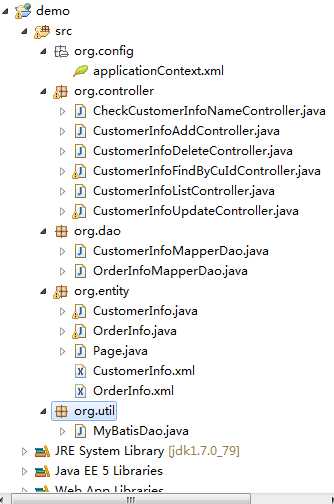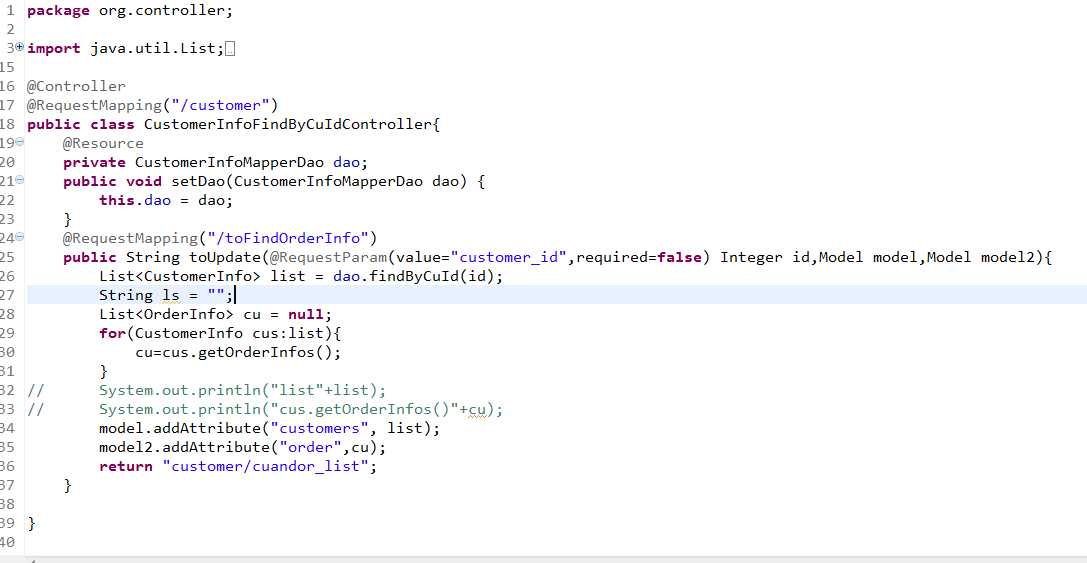标签:
在很多Java EE项目中,Spring+MyBatis框架经常被用到,项目搭建在这里不再赘述,现在要将的是如何在项目中书写,增删改查的语句,如何操作数据库,以及后台如何获取数据,如何进行关联查询,以及MyBatis的分页问题。
首先先看看项目的架构,方便后边叙述。

这个项目中是一个Sping+MyBatis的完整demo(这边将页面没有展示。)这次的主题主要是后台数据处理逻辑。接下来为大家逐一介绍各个文件,
org.config Spring配置包括数据库的链接信息
org.controller 逻辑控制,也就是MVC中的C
org.dao 接口基类
org.entity 实体以及MyBatis语句
org.util 工具类
在数据库中存在两张表,分别为Customer_info,order_info。用这两张表格最后实现多表格的关联查询。
第一步骤:建立与数据库表格字段相一致的实体类:
customerInfo.java

package org.entity; //实现该接口--序列化,将对象写入文件 import java.io.Serializable; import java.util.List; public class CustomerInfo implements Serializable { private Integer customer_id;//客户信息的id private String customer_name;//客户姓名 private String identity_no;//身份证号码 private String job_add;//工作单位 private String tel;//座机号码 private String cellphone;//移动电话 private String adds;//联系地址 private Integer post;//邮编 private String mail;//电子邮箱 //关联查询属性orderInfo private List<OrderInfo> orderInfos; public List<OrderInfo> getOrderInfos() { return orderInfos; } public void setOrderInfos(List<OrderInfo> orderInfos) { this.orderInfos = orderInfos; } public Integer getCustomer_id() { return customer_id; } public void setCustomer_id(Integer customer_id) { this.customer_id = customer_id; } public String getCustomer_name() { return customer_name; } public void setCustomer_name(String customer_name) { this.customer_name = customer_name; } public String getIdentity_no() { return identity_no; } public void setIdentity_no(String identity_no) { this.identity_no = identity_no; } public String getJob_add() { return job_add; } public void setJob_add(String job_add) { this.job_add = job_add; } public String getTel() { return tel; } public void setTel(String tel) { this.tel = tel; } public String getCellphone() { return cellphone; } public void setCellphone(String cellphone) { this.cellphone = cellphone; } public String getAdds() { return adds; } public void setAdds(String adds) { this.adds = adds; } public Integer getPost() { return post; } public void setPost(Integer post) { this.post = post; } public String getMail() { return mail; } public void setMail(String mail) { this.mail = mail; } }
OrderInfo.java

1 package org.entity; 2 3 import java.io.Serializable; 4 import java.sql.Date; 5 6 //订单退货单 7 public class OrderInfo implements Serializable{ 8 private Integer order_id;//订单(退货单)信息的id 9 private String order_type;//订单类型 10 private String order_status;//订单状态 11 private Integer product_id;//商品id 12 private Integer product_account;//商品数量 13 private Double pay_money;//总额 14 private Integer customer_id;//客户id 15 private Date start_date;//开始日期 16 private Date deadline;//要求完成日期 17 private String return_reason;//退货原因 18 public Integer getOrder_id() { 19 return order_id; 20 } 21 public void setOrder_id(Integer order_id) { 22 this.order_id = order_id; 23 } 24 25 public String getOrder_type() { 26 return order_type; 27 } 28 public void setOrder_type(String order_type) { 29 this.order_type = order_type; 30 } 31 public String getOrder_status() { 32 return order_status; 33 } 34 public void setOrder_status(String order_status) { 35 this.order_status = order_status; 36 } 37 public Integer getProduct_id() { 38 return product_id; 39 } 40 public void setProduct_id(Integer product_id) { 41 this.product_id = product_id; 42 } 43 public Integer getProduct_account() { 44 return product_account; 45 } 46 public void setProduct_account(Integer product_account) { 47 this.product_account = product_account; 48 } 49 public Double getPay_money() { 50 return pay_money; 51 } 52 public void setPay_money(Double pay_money) { 53 this.pay_money = pay_money; 54 } 55 public Integer getCustomer_id() { 56 return customer_id; 57 } 58 public void setCustomer_id(Integer customer_id) { 59 this.customer_id = customer_id; 60 } 61 public Date getStart_date() { 62 return start_date; 63 } 64 public void setStart_date(Date start_date) { 65 this.start_date = start_date; 66 } 67 public Date getDeadline() { 68 return deadline; 69 } 70 public void setDeadline(Date deadline) { 71 this.deadline = deadline; 72 } 73 public String getReturn_reason() { 74 return return_reason; 75 } 76 public void setReturn_reason(String return_reason) { 77 this.return_reason = return_reason; 78 } 79 80 81 }
Page.java

1 package org.entity; 2 3 public class Page { 4 //显示第几页数据,默认第一页 5 private Integer page=1; 6 //一页显示几条,默认5条 7 private Integer pageSize = 3; 8 //最大页数 9 private Integer totalPage=1; 10 11 public Integer getTotalPage() { 12 return totalPage; 13 } 14 public void setTotalPage(Integer totalPage) { 15 this.totalPage = totalPage; 16 } 17 //利用page和pageSize计算begin起点 18 public Integer getBegin(){ 19 return (page-1)*pageSize; 20 } 21 //利用page和pageSize计算end结束点 22 public Integer getEnd(){ 23 return page*pageSize+1; 24 } 25 26 public Integer getPage() { 27 return page; 28 } 29 public void setPage(Integer page) { 30 this.page = page; 31 } 32 public Integer getPageSize() { 33 return pageSize; 34 } 35 public void setPageSize(Integer pageSize) { 36 this.pageSize = pageSize; 37 } 38 }
在接下来的这两个文件中,里边详细些了如何进行增删改查,以及多表之间的查询操作等。其中sql语句中的每一个id对应着dao方法中的方法名称。dao文件的内容如下;
customer.xml

1 <?xml version="1.0" encoding="UTF-8" ?> 2 <!DOCTYPE mapper PUBLIC "-//ibatis.apache.org//DTD Mapper 3.0//EN" 3 "http://ibatis.apache.org/dtd/ibatis-3-mapper.dtd"> 4 <mapper namespace="org.dao.CustomerInfoMapperDao"> 5 6 <select id="findAll" 7 resultType="org.entity.CustomerInfo"> 8 select * from customer_info 9 </select> 10 <delete id="deleteCustomer" parameterType="int"> 11 delete from customer_info where customer_id=#{id} 12 </delete> 13 14 <insert id="saveCustomer" parameterType="org.entity.CustomerInfo"> 15 insert into Customer_info(customer_id,customer_name,identity_no, 16 job_add,tel,cellphone,Adds,post,mail) 17 values(customer_seq.nextval,#{customer_name,jdbcType=VARCHAR},#{identity_no,jdbcType=VARCHAR}, 18 #{job_add,jdbcType=VARCHAR},#{tel,jdbcType=VARCHAR},#{cellphone,jdbcType=VARCHAR}, 19 #{adds,jdbcType=VARCHAR},#{post,jdbcType=NUMERIC},#{mail,jdbcType=VARCHAR}) 20 </insert> 21 22 <select id="findByCustomerName" 23 parameterType="java.lang.String" 24 resultType="org.entity.CustomerInfo"> 25 select * from customer_info where customer_name=#{customer_name} 26 </select> 27 <select id="findByCustomerId" parameterType="int" resultType="org.entity.CustomerInfo"> 28 select * from customer_info where customer_id=#{customer_id,jdbcType=NUMERIC} 29 </select> 30 31 <update id="updateCustomerInfo" parameterType="org.entity.CustomerInfo"> 32 update customer_info set customer_name=#{customer_name,jdbcType=VARCHAR}, 33 identity_no=#{identity_no,jdbcType=VARCHAR}, 34 job_add=#{job_add,jdbcType=VARCHAR},tel=#{tel,jdbcType=VARCHAR}, 35 cellphone=#{cellphone,jdbcType=VARCHAR},adds=#{adds,jdbcType=VARCHAR}, 36 post=#{post,jdbcType=NUMERIC},mail=#{mail,jdbcType=VARCHAR} 37 where customer_id=#{customer_id,jdbcType=NUMERIC} 38 </update> 39 <select id="findPage" parameterType="org.entity.Page" resultType="org.entity.CustomerInfo" > 40 select * 41 FROM (select c1.*,rownum rn 42 FROM (select * FROM customer_info order by customer_id)c1) 43 where rn>#{begin} and rn<#{end} 44 45 </select> 46 47 <select id="findRows" resultType="int" > 48 select count(*) from customer_info 49 </select> 50 51 <select id="somethingNotIn" resultType="返回所对应的实体"> 52 SELECT * FROM user WHERE username NOT IN (‘zhang‘,‘wang‘) 53 </select> 54 55 <select id="findByCuId" parameterType="java.lang.Integer" resultMap="cuAndOrderResult"> 56 select o.customer_id,o.order_id,o.order_type,o.order_status,o.product_id,o.product_account,o.start_date, 57 c.customer_name,c.cellphone,c.adds 58 from order_info o left join customer_info c on(o.customer_id=c.customer_id) 59 where o.customer_id=#{customer_id} 60 </select> 61 <resultMap id="cuAndOrderResult" type="org.entity.CustomerInfo" > 62 <id property="customer_id" column="customer_id"/> 63 <result property="customer_name" column="customer_name"/> 64 <result property="cellphone" column="cellphone"/> 65 <result property="adds" column="adds"/> 66 <collection ofType="org.entity.OrderInfo" 67 property="orderInfos" column="customer_id" javaType="java.util.List"> 68 <id property="order_id" column="order_id"/> 69 <result property="order_type" column="order_type"/> 70 <result property="order_status" column="order_status"/> 71 <result property="product_id" column="product_id"/> 72 <result property="product_account" column="product_account"/> 73 <result property="start_date" column="start_date"/> 74 </collection> 75 </resultMap> 76 77 78 <!-- 79 <select id="findByCuId" 80 parameterType="java.lang.Integer" 81 resultMap="cuAndOrderResult"> 82 select o.customer_id,o.order_id,o.order_type,o.order_status,o.product_id,o.product_account, 83 c.customer_name,c.cellphone,c.adds 84 from order_info o join customer_info c on(o.customer_id=c.customer_id) 85 where o.customer_id=#{customer_id} 86 select * from customer_info where customer_id=#{customer_id} 87 88 </select> 89 <select id="selectOrderInfo" 90 parameterType="int" 91 resultType="org.entity.OrderInfo"> 92 select * from order_info where customer_id=#{customer_id} 93 </select> 94 <resultMap id="cuAndOrderResult" type="org.entity.CustomerInfo"> 95 <id column="customer_id" property="customer_id" /> 96 <collection ofType="org.entity.OrderInfo" 97 property="orderInfos" javaType="java.util.ArrayList" 98 column="customer_id" select="selectOrderInfo"> 99 </collection> 100 </resultMap> 101 102 --> 103 104 105 106 107 108 109 110 </mapper>
OrderInfo.xml

1 <?xml version="1.0" encoding="UTF-8" ?> 2 <!DOCTYPE mapper PUBLIC "-//ibatis.apache.org//DTD Mapper 3.0//EN" 3 "http://ibatis.apache.org/dtd/ibatis-3-mapper.dtd"> 4 <mapper namespace="org.dao.OrderInfoMapperDao"> 5 6 <select id="findAll" 7 resultType="org.entity.OrderInfo"> 8 select * from Order_Info 9 </select> 10 11 <select id="findPage" parameterType="org.entity.Page" resultType="org.entity.OrderInfo" > 12 select * 13 FROM (select c1.*,rownum rn 14 FROM (select * FROM Order_Info order by order_id)c1) 15 where rn>#{begin} and rn<#{end} 16 17 </select> 18 19 <select id="findRows" resultType="int" > 20 select count(*) from Order_Info 21 </select> 22 23 </mapper>
CustomerInfoMapperDao.java

1 package org.dao; 2 3 import java.util.List; 4 5 import org.entity.CustomerInfo; 6 import org.entity.Page; 7 import org.util.MyBatisDao; 8 9 10 11 //xml文件中的方法,然后在Controller中调用该方法 12 @MyBatisDao 13 public interface CustomerInfoMapperDao { 14 public List<CustomerInfo> findAll(); 15 public void deleteCustomer(int id); 16 public void saveCustomer(CustomerInfo customer); 17 public CustomerInfo findByCustomerName(String customer_name); 18 public CustomerInfo findByCustomerId(int id); 19 public List<CustomerInfo> findByCuId(int id);//根据cuid查询客户的订单信息 20 public void updateCustomerInfo(CustomerInfo customer); 21 //分页操作 22 public List<CustomerInfo> findPage(Page page); 23 public int findRows(); 24 25 }
接下来主要来说一下,MyBatis中的多表关联问题。多表关联主要对应customer.xml中的这段代码;

在controller中的代码如下:

从图中可以看到,在这边使用了一个增强的for循环来进行处理,这样就实现了多表之间的关联查询,接下来将数据显示到前台页面即可。
主要代码:

1 List<CustomerInfo> list = dao.findByCuId(id); 2 String ls = ""; 3 List<OrderInfo> cu = null; 4 for(CustomerInfo cus:list){ 5 cu=cus.getOrderInfos(); 6 } 7 model.addAttribute("customers", list); 8 model2.addAttribute("order",cu);
Spring+MyBatis框架中sql语句的书写,数据集的传递以及多表关联查询
标签:
原文地址:http://www.cnblogs.com/DonaHero/p/5798774.html